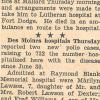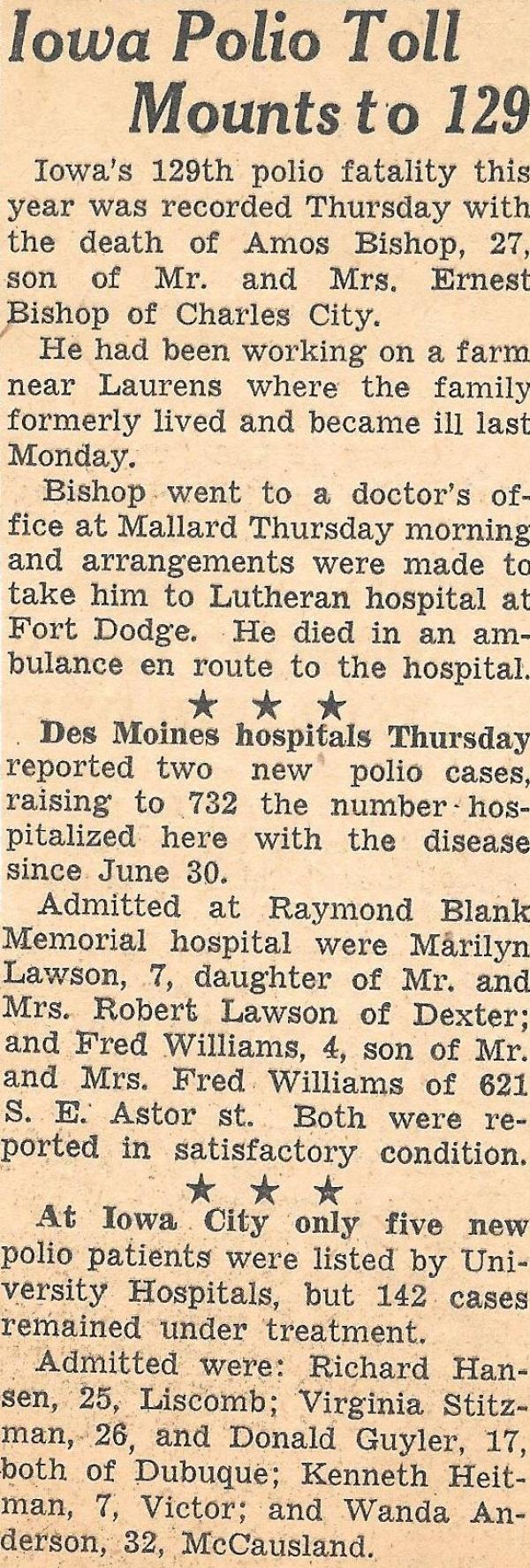Polio: The Childhood Killer
| Grade | 9th -12th Grades | Class | U.S. History | Length of Lesson | 50 Minutes |
| Lesson Title | Polio: The Childhood Killer |
| Unit Title | |
| Unit Compelling Question | What was polio, what were the effects, and how could it be fatal? |
| Historical Context: 2018.009.038 In 1952, Bode was experiencing flu-like symptoms when she was taken to the Des Moines Hospital and diagnosed with polio. She was admitted to the Blank Children's Hospital and placed in a ward with other polio patients. While in the hospital, Bode received treatment to help keep her muscles healthy such as stretches and wrapping her arms and legs in wet hot packs made of steaming wool that were then covered in plastic. The procedure often resulted in burns and blisters forming, a painful memory for Bode. Another painful memory was seeing a boy in an iron lung machine. The hospital soon became overrun with patients and Bode was sent home since she was no longer contagious. Bode was forced to continue her physical therapy exercises despite her hatred of them. She wrote a book called My Mean Mom describing her experience. |
|
| Lesson Supporting Question | |
| Lesson Overview | Students will be shown an image of a newspaper clipping from 1952, one year before Jonas Salk developed the polio vaccine, and will be asked questions about it. Even over 65 years ago, polio was still a common childhood disease and could lead to paralyzation and even death. This is a lesson about polio and what some of its symptoms can lead to. One of the stories mentioned in the newspaper clipping (Marilyn Lawson, age 7, of Dexter) would end up surviving the disease and write a children’s book (My Mean Mom) about it later on in her life. |
| Primary Sources Used |
|
| Resources Needed | https://www.historyofvaccines.org/content/blog/sioux-city-polio-epidemic-1952 https://joynealkidney.com/2019/08/08/polio-dexter-iowa/ http://www.iowapbs.org/iowapathways/mypath/polio-iowa https://www.iowaheritage.org/exhibits/show/polio1/polio2 |
| Standard | |
| Lesson Target | Students will be able to understand how primary sources can tell how people thought and felt about something like polio.;Students will be able to understand the short-term and long-term effects of polio. |
| Lesson Themes | Disaster and Crisis, Health & Wellness |
|
| Formative Assessment (How will you use the formative assessments to monitor and inform instruction?) |
Students will be assessed based off of their discussions with their small groups and seeing what they inferred from the primary source and the articles. They will also be assessed off of their exit tickets and worksheets by seeing if they can connect the effects of polio and the vaccine for it |
| Summative Assessment (How does the lesson connect to planned summative assessment(s)?) |
| Author | Tyler Hosch | Created | Last Edited | ||||
| Reviewer: Chad Christopher, History Education, University of Northern Iowa | |||||||
| Lesson Plan Development Notes: Teaching Methods, University of Northern Iowa, Fall 2019 | |||||||


